MARKETING
The Ultimate Guide to SEO for E-commerce Websites

If you’re retailing products and want to reach the widest audience possible, having a well-optimized e-commerce website is an absolute must.
Why? Well, there are several benefits.
A great e-commerce website helps you understand the basics about your customers, for example, demographics like their locations, age groups, and how they found you.
By using tracking, you can then use your visitor’s information for behavior analysis to get to know them even better.
An e-commerce website does more than this, though. It can also help you understand where things are going wrong. For example, which traffic sources don’t work, which offers don’t appeal, and cart abandonment issues and their potential causes.
Of course, the more obvious reason you would want to have your site fully optimized: the growth of e-commerce worldwide. Year on year, e-commerce keeps growing, and this pattern looks like it will continue.
If you’re already online, that’s great. However, you risk remaining invisible to fresh prospects and new leads if you don’t take proactive steps to increase visibility.
How do you do that? It’s simple enough: with SEO for e-commerce.
What Is SEO for E-Commerce?
SEO for e-commerce is a strategy that helps web retailers rank higher in search engine results. A well-designed and optimized website with high-quality content will rank better in search engines such as Google, increasing your store’s visibility and driving traffic.
In other words, SEO for e-commerce concentrates on optimizing your site, which makes it easier to get leads and conversions.
However, unlike SEO for content-focused websites, SEO for e-commerce is more than just adding keywords, writing blog posts, and gaining links. You need to understand how search engines work and what they reward.
That means having a working knowledge of SEO for e-commerce, considering Google’s guidelines, analyzing buyer intent, and implementing it strategically.
E-Commerce SEO Best Practices
E-commerce for SEO is a complex field, and with millions of online retail sites in existence, it’s not always easy to make your site stand out.
While it might seem like a huge challenge to build your SEO rankings, you can make a positive start by applying some best practices. In time, this increases your chances of visibility and gaining more organic leads and customers.
For the unfamiliar, what do best practices for SEO for e-commerce look like? Well, you could start by addressing fundamentals like:
- navigation
- internal links
- avoiding clutter
- creating unique content
- including alt text for images
However, there’s far more you can do. Below, explore our list of SEO for e-commerce best practices you can implement today.
1. Perform Keyword Research the Right Way
There are many different ways to optimize your e-commerce site, and not every approach is suitable for every site or product. However, some guidelines apply to every online retailer, and one of them is performing keyword research correctly.
Yes, you want the most relevant and popular keywords in your industry, but you must also understand buyer intent.
Keyword intent is the intention behind a search query. You can identify it by looking at the specific phrases and terms people use when looking for an item online.
There are two main types of keyword intent you see most often.
Informational Keyword Intent
Informational keyword intent is used in SEO to describe the type of information the searcher is looking for.
These types of searches usually consist of:
- How tos: These are searches that contain questions such as “how do I?”
- Direct purchase: These involve searches with keywords like “buy this.”
- Factual queries: These use words such as “fact” and “information” when a searcher wants more details about a subject.
Commercial Keyword Intent
Commercial keyword intent is when people are looking for information to help them make a purchase. This means that they want to find what they need and buy it as fast as possible.
Consumers typically use commercial keyword intents when they know what they want but don’t know where to find it yet. You see this when you’re typing specific terms into Google like “buy digital camera” or “find new laptop deals.”
Commercial keyword users typically have more intent to purchase and are less likely to search for information about the product or service than just researching where to find it.
Determining Keyword Intent
Deciding consumers’ keyword intent seems challenging, but you can make it easier on yourself. For example, AgencyAnalytics breaks it down into stages.
- Analyzing SERPs: Pay special attention to paid ads, knowledge graph results, and organic listings.
- Look at Google ads for commercial intent: Seeing bid prices for keywords gives an idea of how competitive keywords are.
- Review your analytics: Look for content with high bounce rates as it may mean it doesn’t match with searcher intent.
You could also use keyword tools like Google’s keyword planner. Others you can try include:
Ubersuggest
Ubersuggest is a free online tool that can find long-tail and related words to any topic or keyword, or you can opt for the paid version.
This tool is great for content writers, bloggers, copywriters, and marketers who want to generate new content ideas or find out what users are searching for about a given topic.
Features include:
- backlink data
- rank tracking
- site audit reports
Backlink Data
To see what backlinks you are getting from other sites, go to the backlink analyzer under SEO Explorer. This can help you see who is already a fan and what related sites you can target for more linkbuilding.
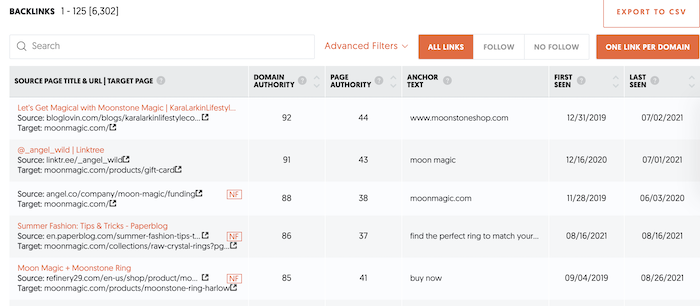
Rank Tracking
See how you rank in organic SERPs for your target keywords with Ubersuggest rank tracking. That way, you can see how you have improved over time. This is under Dashboard on the left side.
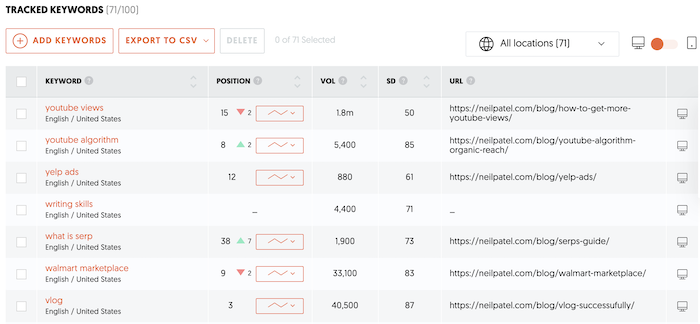
Site Audit
Run a site audit to track what issues need to be fixed on your site that could be affecting user experience and organic traffic. Think of the audit as a starting point, then review it regularly to make sure you’re fixing other issues. This is under the SEO Analyzer section. One the audit has run, it will tell you your top SEO issues and how to fix them.

It also has a free chrome extension to do keyword research while you’re conducting Google or YouTube searches.
Answer the Public
Answer the Public is a great tool. It lets you uncover what people all over the world are curious about and going through.
Answer the Public is intuitive, too. Just enter your keyword on the homepage to understand precisely what people are asking. It can also help you find which topics are most popular at any given time, which might be helpful as another tool for keyword research. However, if you want further guidance, there’s a set of tutorials available.
It’s free to use, but you can upgrade to pro for more features. The following example uses “multivitamins.”
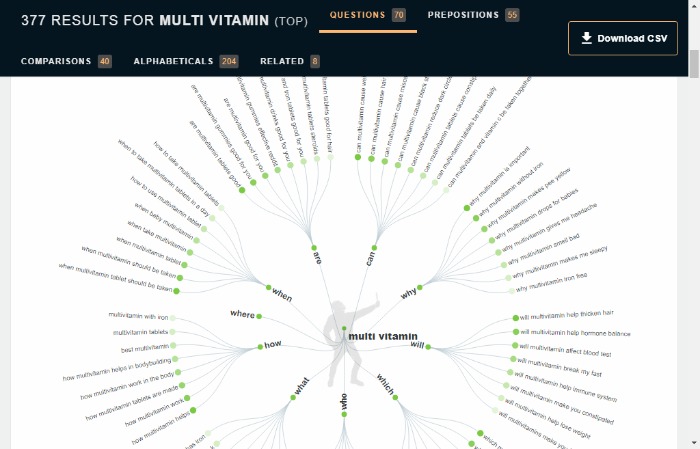
The results give a detailed picture of the kind of questions people are asking and give a better idea of intent.
2. Optimize Product Pages to Improve Ranking
If you want to attract and acquire new customers, look at your on-page user optimization. It matters because it gets your site a higher rank, meaning fresh streams of organic traffic and more conversions.
Not every area of your e-commerce site needs optimizing, so in this section, let’s focus on the ones that matter most to online retailers: product descriptions, images, and reviews.
Optimize Your Product Descriptions
A product page is interesting because it has a lot of different features that all need attention. You also want a few things to stand out from the page to gain visitors’ engagement and get them to click through.
To begin optimizing your e-commerce product pages, you need to keep in mind three key aspects:
- What are the most crucial things on the page?
- How can you maximize visibility and impact with these elements?
- How can you use this information to improve your product description’s effectiveness?
Now, start looking at what you can do to maximize the impact of your product descriptions. This could be things like.
- adding multiple, high-quality, unique images
- including keywords
- including detailed, keyword-rich descriptions
- adding calls to action (CTAs)
- including testimonials
Optimize Your Images
A sometimes neglected area of SEO for e-commerce is images. Photos are an excellent way to communicate a message and draw in an audience. However, they can also distract people from the message you are trying to convey, so be careful not to use too many images and crowd your descriptions.
Although quality images are vital to show your goods at their best, there’s more to it than that. Optimizing your images for SEO will give you higher search engine rankings and more traffic from potential customers and may gain you traffic from social media channels.
Here are some pointers for optimizing your images:
- Choose suitable images for your platform. Your host usually specifies optimal image sizes and other image guidelines.
- Provide captions with alt tags for pictures.
- Use the right keywords in file names.
Feature Reviews
Reviews provide a snippet of information that helps shoppers weigh whether to go with a particular product or store.
Reviews are vital for success in e-commerce as so many people rely on them. Additionally, they help you build trust with your potential customers and improve conversion rates.
You can encourage customers to leave reviews by sending automated messages whenever they purchase. You can also set up email campaigns to send out reminders or offers once they have left a review on your site.
Before moving on, here are more optimization tips:
- Use canonical tags to link duplicate product pages and similar group products together.
- Create a well-written page that includes the necessary information about the product, an image of the product, and a video of it in action.
- Include at least one CTA on your product page. For example, “Add To Cart” or “Check Availability.”
- Make sure you include shipping details and policies upfront so customers know what they’re paying from the start.
3. Make Sure Your Site Is User Friendly
UX stands for user experience. You can enhance UX by good design, making the aesthetics more visually appealing.
However, it’s not just about making a website look good; it’s about making it work well. UX includes everything from navigation, ease of use, and the overall “feel” of the website.
UX is also about making sure people can find what they are looking for, keeping them engaged while browsing, and giving visitors the best experience possible.
You may not think that UX affects SEO, but the interaction between the two began some years ago, and UX is also imperative for discoverability.
Additionally, recent changes mean that UX is soon to be a Google ranking factor. According to Search Engine Land, that means if Google thinks your website offers visitors a bad experience, it may rank lower. Google measures the new ranking with “Core Web Vitals” and has set out its guidelines online.
Many things can influence UX, but a few key factors are apparent:
- Ads shouldn’t interfere with the user’s view of content.
- Your site should load quickly and be mobile-friendly.
- Any website should be clutter-free and easy to navigate.
- You should include CTAs, so customers know what to do next.
Finally, use consistent styling throughout, and make it accessible.
4. Don’t Forget Long-Tail Keywords
You usually see long-tail keywords on the right side of a search engine results page (SERP).
A long-tail keyword is a term that typically has low search volume but still meets the criteria for relevancy to your business. They also tend to convert well because they’re a better match for what the searcher is looking for, and they typically give higher traffic.
For those reasons, you shouldn’t be afraid to rank for long-tail keywords because they’re a valuable source of traffic.
Long-tail keywords are great for:
- competitive niches
- increased conversion rates
- ranking new sites more easily
You can find long-tail keywords by using Google’s “People also ask” or use a free keyword tool like Ubersuggest. There are plenty of other tools available too.
The following example uses Wordtracker, where the search for “dumbells” delivered this:
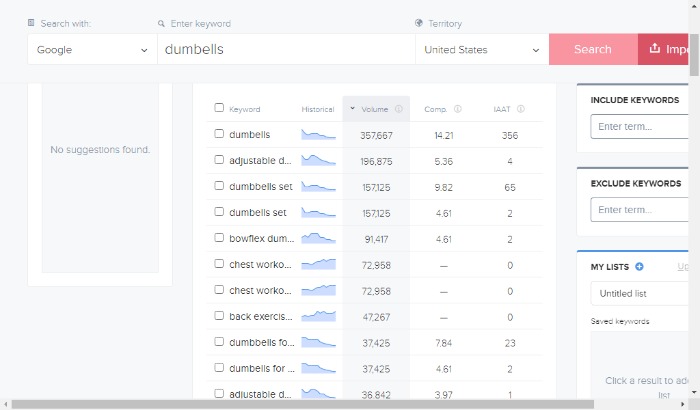
As you can see, they give you a firm idea of what your customer is looking for and of their intentions.
5. Use a Simple URL Structure
There are more detailed guides on URL structures, but this section gives you the basics.
A simple URL structure not only enhances the user experience but also improves your SEO e-commerce efforts to some extent.
Additionally, when your e-commerce site has a simple URL structure, it’s easier to share products on social media and other websites, and it can improve SEO for e-commerce as it provides more relevant data for search engines.
For the best results, URLs should be as readable and understandable as possible.
For instance, here’s an example of what NOT to do: https://www.example.com/article-about-hiking/
It would be much better to use this URL structure: https://www.example.com/hiking-articles
Google also has some advice on improving URL structure.
Additionally, you can:
Use Keywords
Search engines scan the URL and use the keywords in the URL to determine where that page should rank in the SERPs. The keywords in the URL are called “metatags” and help tell search engines what the content or topic of that page is.
That’s why you must spend some time thinking about your keywords before deciding on a URL structure.
When people search for your business online, they often type in the precise words they’re looking for. As an example, a person may type in “online shoe store” into a search engine.
Therefore, when someone types in “online shoe store,” it’s crucial those words are somewhere in your URL structure.
Use Breadcrumbs
Breadcrumbs are a navigational tool. They allow website visitors to retrace previous steps and return to where they started. Breadcrumbs are not just a usability technique but also provide additional SEO benefits.
For example, if you visit a blog post from your main homepage, the breadcrumb for that post would be “Home > Blog > This Post.”
You find breadcrumbs in many web design tools, and you can add them by using markup tags or via JavaScript.
Avoid Stop Words
Common stop words are “the,” “and,” “of,” and “a.”
Stop words can decrease your content’s readability and may lower your SEO rankings.
In addition, stop words are less likely to hold a reader’s interest. By removing these words from your website, you can use those spaces for more creative and relevant copy.
6. Use Schema Markups to Help Google and Users Understand Content
Schema markups are HTML tags that provide additional information about the content on web pages. By using these markups, it can improve your SEO for e-commerce efforts.
When you use schema markup, it produces rich snippets. These are a way for search engines to show more information about specific items in the search results.
They also help people find what they are looking for faster and easier by showing different types of information.
There are many different types of rich snippets, such as:

The kinds of e-commerce schema are:
- Product schema: This is an extension for products, services, and organizations. It enables discovering new products and services in web search queries by providing rich product information such as images, price, and availability. Product schema also allows the display of product ads on the SERPs.
- Review schema: This enables online reviews. The author and title filters allow you to find specific people who have written reviews on your website or blog post and for searchers to find product reviews.
- Product availability schema: The product availability schema is a list of products that are available to purchase. It can be a single page, or it can be within an online store. Such lists typically detail the product name, description, price, images, and variants.
- Video schema: Video schema is a type of metadata used to describe the content and format. For example, video schema may include the audio language, video resolution, or age rating of the video.
- Price schema: Price schema is a technique for the pricing of products or a price range.
7. Avoid Duplicate Pages and Content
Have you ever visited a website and got the feeling you’ve read it all somewhere before? That’s all too common with production descriptions and category descriptions when online retailers use duplicate product catalogs and images.
It’s understandable why e-commerce sellers just republish the same descriptions. Usually, it’s simply because they don’t have the resources to produce fresh content themselves.
However, even if you don’t have time to rewrite everything, you can still significantly reduce the amount of duplication on your site in product descriptions and other areas.
For instance, by
- using a CMS with site-wide 301 redirects or adding canonical tags on every page that you know might have duplicates (pages with similar titles, pages that share an identical URL, etc.)
- adding a suffix to the URL
- using different product images
- adding unique keywords on other pages
8. Don’t Let Page Speed Kill Your Ranking
Website page speed loading time is the measurement of how long it takes for an internet user to open a web page. You can measure it by adding up the time to download all the non-hidden assets, such as images, scripts, and stylesheets.
Page speed is a ranking factor, and survey after survey shows consumers aren’t willing to wait around while a site loads.
Web-users say their ideal site speed is just two seconds, but the faster, the better. If you’re not sure about your current speeds, you can test it at Cloudflare or try Google’s tool.
What should you do if your site is too slow? First, you need to find the reason. It could be:
- Your site simply has too much content for your server to handle.
- Too many scripts are slowing down load times.
- Images take an excessive amount of time to load.
- There’s a problem with your web host.
While not all e-commerce site owners can guarantee a perfect 100 percent on Google’s PageSpeed Insights, you can try and fasten load times by:
- having fewer images on the pages
- compressing files
- using fewer social media widgets
- optimizing your images
- avoiding clutter and using plenty of white space
- limiting redirects and HTTP requests
- fastening your server response time
Additionally, you might want to think about changing web hosts or upgrading your hosting package to accommodate your needs better.
9. Content Does Matter for E-Commerce
E-commerce isn’t just about images and keywords. Written content should also be part of your SEO for e-commerce strategy.
Posting regular content not only attracts organic traffic. It can gain your customers’ trust, boost your website rankings, and solidify your reputation as an expert in your niche too.
There are many types of content you can focus on:
- sharing how-to pieces and answering FAQs
- new product launches and anything newsworthy
- a glossary page
- including user-generated content (UGC)
- testimonials and launches
- video demonstrations and Q and As
- webinars
For more ideas, take it a step further and get to know your audience so you understand their main concerns and problems. This allows you to write content that addresses their everyday worries and offer products that solve these.
Now you’ve got some ideas for content. However, content isn’t worthwhile without a strategy behind it. Let’s break it down:
- Get to know your customers better with buyer personas.
- Understand their preferred content. If you’re tracking your content data, you should see which content types get the most views. Additionally, you can ask customers and prospects through surveys or groups.
- Establish a content calendar and create the content.
- Publish the appropriate content for the various stages of the buying cycle.
- Use A/B testing in key areas like titles.
- Measure the results and tweak.
10. Link Building for E-Commerce
Link building is a ranking factor for SEO. Quality links tell Google that your site has credibility. Backlinks also influence how your website ranks for keywords.
Sounds great, doesn’t it? But just how do you go about creating these all-important backlinks?
A few ways to do this are:
- creating internal backlinks
- writing guest posts
- using social media ads
- sharing content on social media
- issuing press releases
- writing blog comments and sharing on forums (if allowed)
- creating infographics and sharing them online
- issuing whitepapers and case studies
These are all legitimate ways to build quality links. Although they can take time, you shouldn’t take shortcuts by buying links. Some paid links violate Google’s guidelines, and if you’re buying cheap links, the quality is usually questionable. Poor quality links lead to lower SERP rankings and reduced traffic, as well as a potential negative impact on your site’s reputation.
11. Add a Sitemap
A sitemap is a visual representation of your website or digital product. It provides visitors with a bird’s eye view of the website and explores different pages.
Your sitemap should detail all of the pages on your site, from category pages to product pages. It should also include all the subcategories, products, and other content within those sections.
You can develop a sitemap manually or use an automated tool such as Google’s Webmaster Tools to generate one. Sitemaps use both XML and HTML, although HTML sitemaps are more helpful to visitors.
Other tools for creating a sitemap are:
Lucid Sitemap Generator
The Lucid chart sitemap generator is a user-friendly tool that makes creating a sitemap for your website easy. It has many features, like adding categories and subcategories.
Powermapper
Powermapper is an easy-to-use tool for creating and updating sitemaps and allows you to generate one-click checkouts.
It’s a web-based tool with no coding expertise required. However, there is a fee.
12. Make Social Sharing Easy
Google’s Matt Cutts once said that social sharing doesn’t impact SEO, but many would disagree.
While social media sharing may not directly affect your SEO, sharing your content on social media increases brand exposure and gets people more familiar with your business.
Further, the more mentions you get on social media, the more influence this can have on your SEO by:
- driving organic traffic and increasing visibility
- improving local SEO
- expanding your content reach and enhancing brand recognition
- increasing backlinks
If you want an easy way to increase your shares on social media, consider getting a tool like Buffer or Hootsuite to automatically post content from your site across all of your social media accounts at scheduled intervals.
Frequently Asked Questions About SEO for E-Commerce
How do I Find the Right Keywords For my E-commerce Store?
There are several free resources that you can use to find keyword ideas, such as Google AdWords, Ubersuggest, and Google’s Keyword Tool. You should also look at what your competitors are using to find the best keywords for their audience.
Finally, avoid using broad keywords that generate many clicks but don’t provide much conversion value. Use long-tail keywords where you can.
How Much Does SEO for E-Commerce Cost?
The cost of SEO depends on many factors, including the number of keywords targeted, competitive landscape, and how much effort you need to optimize each page for ranking.
It’s not easy to put a price tag on SEO because it depends on how many resources you allocate and what you want to achieve. To help you budget, Search Engine Journal provides an SEO budget calculator.
What Is SEO for E-Commerce?
SEO for e-commerce is the process of optimizing a website so that it can rank more highly in search engines. Several factors affect how well a website ranks on the SERPs, such as the quality and relevance of the content, the use of appropriate keywords to optimize the site, and the site’s load speed.
How Is SEO for E-Commerce Different?
When it comes to SEO for e-commerce, there are different areas you need to focus on, such as optimizing:
- product pages and descriptions
- diversifying product content and information
- images on your website
- your homepage
SEO for E-Commerce Conclusion
SEO for e-commerce helps boost your website visibility, brings new queries and customers, and helps build your loyal audience.
It may seem like there’s a lot to think about. However, by concentrating on the main SEO best practices and optimizing the critical areas of your website, it doesn’t have to be as complicated as it sounds.
The most important thing to remember is SEO for e-commerce doesn’t happen overnight. Instead, it’s an ongoing strategy that requires updating as you go to get the optimum results.
What is your experience of SEO for e-commerce? Tell us below.
See How My Agency Can Drive Massive Amounts of Traffic to Your Website
- SEO – unlock massive amounts of SEO traffic. See real results.
- Content Marketing – our team creates epic content that will get shared, get links, and attract traffic.
- Paid Media – effective paid strategies with clear ROI.
MARKETING
5 Psychological Tactics to Write Better Emails

Welcome to Creator Columns, where we bring expert HubSpot Creator voices to the Blogs that inspire and help you grow better.
I’ve tested 100s of psychological tactics on my email subscribers. In this blog, I reveal the five tactics that actually work.
You’ll learn about the email tactic that got one marketer a job at the White House.
You’ll learn how I doubled my 5 star reviews with one email, and why one strange email from Barack Obama broke all records for donations.
5 Psychological Tactics to Write Better Emails
Imagine writing an email that’s so effective it lands you a job at the White House.
Well, that’s what happened to Maya Shankar, a PhD cognitive neuroscientist. In 2014, the Department of Veterans Affairs asked her to help increase signups in their veteran benefit scheme.
Maya had a plan. She was well aware of a cognitive bias that affects us all—the endowment effect. This bias suggests that people value items higher if they own them. So, she changed the subject line in the Veterans’ enrollment email.
Previously it read:
- Veterans, you’re eligible for the benefit program. Sign up today.
She tweaked one word, changing it to:
- Veterans, you’ve earned the benefits program. Sign up today.
This tiny tweak had a big impact. The amount of veterans enrolling in the program went up by 9%. And Maya landed a job working at the White House

Inspired by these psychological tweaks to emails, I started to run my own tests.
Alongside my podcast Nudge, I’ve run 100s of email tests on my 1,000s of newsletter subscribers.
Here are the five best tactics I’ve uncovered.
1. Show readers what they’re missing.
Nobel prize winning behavioral scientists Daniel Kahneman and Amos Tversky uncovered a principle called loss aversion.
Loss aversion means that losses feel more painful than equivalent gains. In real-world terms, losing $10 feels worse than how gaining $10 feels good. And I wondered if this simple nudge could help increase the number of my podcast listeners.
For my test, I tweaked the subject line of the email announcing an episode. The control read:
“Listen to this one”
In the loss aversion variant it read:
“Don’t miss this one”
It is very subtle loss aversion. Rather than asking someone to listen, I’m saying they shouldn’t miss out. And it worked. It increased the open rate by 13.3% and the click rate by 12.5%. Plus, it was a small change that cost me nothing at all.

2. People follow the crowd.
In general, humans like to follow the masses. When picking a dish, we’ll often opt for the most popular. When choosing a movie to watch, we tend to pick the box office hit. It’s a well-known psychological bias called social proof.
I’ve always wondered if it works for emails. So, I set up an A/B experiment with two subject lines. Both promoted my show, but one contained social proof.
The control read: New Nudge: Why Brands Should Flaunt Their Flaws
The social proof variant read: New Nudge: Why Brands Should Flaunt Their Flaws (100,000 Downloads)
I hoped that by highlighting the episode’s high number of downloads, I’d encourage more people to listen. Fortunately, it worked.
The open rate went from 22% to 28% for the social proof version, and the click rate, (the number of people actually listening to the episode), doubled.
3. Praise loyal subscribers.
The consistency principle suggests that people are likely to stick to behaviours they’ve previously taken. A retired taxi driver won’t swap his car for a bike. A hairdresser won’t change to a cheap shampoo. We like to stay consistent with our past behaviors.
I decided to test this in an email.
For my test, I attempted to encourage my subscribers to leave a review for my podcast. I sent emails to 400 subscribers who had been following the show for a year.
The control read: “Could you leave a review for Nudge?”
The consistency variant read: “You’ve been following Nudge for 12 months, could you leave a review?”
My hypothesis was simple. If I remind people that they’ve consistently supported the show they’ll be more likely to leave a review.
It worked.
The open rate on the consistency version of the email was 7% higher.
But more importantly, the click rate, (the number of people who actually left a review), was almost 2x higher for the consistency version. Merely telling people they’d been a fan for a while doubled my reviews.
4. Showcase scarcity.
We prefer scarce resources. Taylor Swift gigs sell out in seconds not just because she’s popular, but because her tickets are hard to come by.
Swifties aren’t the first to experience this. Back in 1975, three researchers proved how powerful scarcity is. For the study, the researchers occupied a cafe. On alternating weeks they’d make one small change in the cafe.
On some weeks they’d ensure the cookie jar was full.
On other weeks they’d ensure the cookie jar only contained two cookies (never more or less).
In other words, sometimes the cookies looked abundantly available. Sometimes they looked like they were almost out.
This changed behaviour. Customers who saw the two cookie jar bought 43% more cookies than those who saw the full jar.
It sounds too good to be true, so I tested it for myself.
I sent an email to 260 subscribers offering free access to my Science of Marketing course for one day only.
In the control, the subject line read: “Free access to the Science of Marketing course”
For the scarcity variant it read: “Only Today: Get free access to the Science of Marketing Course | Only one enrol per person.”
130 people received the first email, 130 received the second. And the result was almost as good as the cookie finding. The scarcity version had a 15.1% higher open rate.

5. Spark curiosity.
All of the email tips I’ve shared have only been tested on my relatively small audience. So, I thought I’d end with a tip that was tested on the masses.
Back in 2012, Barack Obama and his campaign team sent hundreds of emails to raise funds for his campaign.
Of the $690 million he raised, most came from direct email appeals. But there was one email, according to ABC news, that was far more effective than the rest. And it was an odd one.
The email that drew in the most cash, had a strange subject line. It simply said “Hey.”
The actual email asked the reader to donate, sharing all the expected reasons, but the subject line was different.
It sparked curiosity, it got people wondering, is Obama saying Hey just to me?
Readers were curious and couldn’t help but open the email. According to ABC it was “the most effective pitch of all.”
Because more people opened, it raised more money than any other email. The bias Obama used here is the curiosity gap. We’re more likely to act on something when our curiosity is piqued.

Loss aversion, social proof, consistency, scarcity and curiosity—all these nudges have helped me improve my emails. And I reckon they’ll work for you.
It’s not guaranteed of course. Many might fail. But running some simple a/b tests for your emails is cost free, so why not try it out?
This blog is part of Phill Agnew’s Marketing Cheat Sheet series where he reveals the scientifically proven tips to help you improve your marketing. To learn more, listen to his podcast Nudge, a proud member of the Hubspot Podcast Network.
MARKETING
The power of program management in martech

As a supporter of the program perspective for initiatives, I recognize the value of managing related projects, products and activities as a unified entity.
While one-off projects have their place, they often involve numerous moving parts and in my experience, using a project-based approach can lead to crucial elements being overlooked. This is particularly true when building a martech stack or developing content, for example, where a program-based approach can ensure that all aspects are considered and properly integrated.
For many CMOs and marketing organizations, programs are becoming powerful tools for aligning diverse initiatives and driving strategic objectives. Let’s explore the essential role of programs in product management, project management and marketing operations, bridging technical details with business priorities.
Programs in product management
Product management is a fascinating domain where programs operate as a strategic framework, coordinating related products or product lines to meet specific business objectives.
Product managers are responsible for defining a product or product line’s strategy, roadmap and features. They work closely with program managers, who ensure alignment with market demands, customer needs and the company’s overall vision by managing offerings at a program level.
Program managers optimize the product portfolio, make strategic decisions about resource allocation and ensure that each product contributes to the program’s goals. One key aspect of program management in product management is identifying synergies between products.
Program managers can drive innovation and efficiency across the portfolio by leveraging shared technologies, customer insights, or market trends. This approach enables organizations to respond quickly to changing market conditions, seize emerging opportunities and maintain a competitive advantage. Product managers, in turn, use these insights to shape the direction of individual products.
Moreover, programs in product management facilitate cross-functional collaboration and knowledge sharing. Program managers foster a holistic understanding of customer needs and market dynamics by bringing together teams from various departments, such as engineering, marketing and sales.
Product managers also play a crucial role in this collaborative approach, ensuring that all stakeholders work towards common goals, ultimately leading to more successful product launches and enhanced customer satisfaction.
Dig deeper: Understanding different product roles in marketing technology acquisition
Programs in project management
In project management, programs provide a structured approach for managing related projects as a unified entity, supporting broader strategic objectives. Project managers are responsible for planning, executing and closing individual projects within a program. They focus on specific deliverables, timelines and budgets.
On the other hand, program managers oversee these projects’ coordination, dependencies and outcomes, ensuring they collectively deliver the desired benefits and align with the organization’s strategic goals.
A typical example of a program in project management is a martech stack optimization initiative. Such a program may involve integrating marketing technology tools and platforms, implementing customer data management systems and training employees on the updated technologies. Project managers would be responsible for the day-to-day management of each project.
In contrast, the program manager ensures a cohesive approach, minimizes disruptions and realizes the full potential of the martech investments to improve marketing efficiency, personalization and ROI.
The benefits of program management in project management are numerous. Program managers help organizations prioritize initiatives that deliver the greatest value by aligning projects with strategic objectives. They also identify and mitigate risks that span multiple projects, ensuring that issues in one area don’t derail the entire program. Project managers, in turn, benefit from this oversight and guidance, as they can focus on successfully executing their projects.
Additionally, program management enables efficient resource allocation, as skills and expertise can be shared across projects, reducing duplication of effort and maximizing value. Project managers can leverage these resources and collaborate with other project teams to achieve their objectives more effectively.
Dig deeper: Combining martech projects: 5 questions to ask
Programs in marketing operations
In marketing operations, programs play a vital role in integrating and managing various marketing activities to achieve overarching goals. Marketing programs encompass multiple initiatives, such as advertising, content marketing, social media and event planning. Organizations ensure consistent messaging, strategic alignment, and measurable results by managing these activities as a cohesive program.
In marketing operations, various roles, such as MOps managers, campaign managers, content managers, digital marketing managers and analytics managers, collaborate to develop and execute comprehensive marketing plans that support the organization’s business objectives.
These professionals work closely with cross-functional teams, including creative, analytics and sales, to ensure that all marketing efforts are coordinated and optimized for maximum impact. This involves setting clear goals, defining key performance indicators (KPIs) and continuously monitoring and adjusting strategies based on data-driven insights.
One of the primary benefits of a programmatic approach in marketing operations is maintaining a consistent brand voice and message across all channels. By establishing guidelines and standards for content creation, visual design and customer interactions, marketing teams ensure that the brand’s identity remains cohesive and recognizable. This consistency builds customer trust, reinforces brand loyalty and drives business growth.
Programs in marketing operations enable organizations to take a holistic approach to customer engagement. By analyzing customer data and feedback across various touchpoints, marketing professionals can identify opportunities for improvement and develop targeted strategies to enhance the customer experience. This customer-centric approach leads to increased satisfaction, higher retention rates and more effective marketing investments.
Dig deeper: Mastering the art of goal setting in marketing operations
Embracing the power of programs for long-term success
We’ve explored how programs enable marketing organizations to drive strategic success and create lasting impact by aligning diverse initiatives across product management, project management and marketing operations.
- Product management programs facilitate cross-functional collaboration and ensure alignment with market demands.
- In project management, they provide a structured approach for managing related projects and mitigating risks.
- In marketing operations, programs enable consistent messaging and a customer-centric approach to engagement.
Program managers play a vital role in maintaining strategic alignment, continuously assessing progress and adapting to changes in the business environment. Keeping programs aligned with long-term objectives maximizes ROI and drives sustainable growth.
Organizations that invest in developing strong program management capabilities will be better positioned to optimize resources, foster innovation and achieve their long-term goals.
As a CMO or marketing leader, it is important to recognize the strategic value of programs and champion their adoption across your organization. By aligning efforts across various domains, you can unlock the full potential of your initiatives and drive meaningful results. Try it, you’ll like it.
Fuel for your marketing strategy.
Opinions expressed in this article are those of the guest author and not necessarily MarTech. Staff authors are listed here.
MARKETING
2 Ways to Take Back the Power in Your Business: Part 2


Before we dive into the second way to assume power in your business, let’s revisit Part 1.
Who informs your marketing strategy?
YOU, with your carefully curated strategy informed by data and deep knowledge of your brand and audience? Or any of the 3 Cs below?
- Competitors: Their advertising and digital presence and seemingly never-ending budgets consume the landscape.
- Colleagues: Their tried-and-true proven tactics or lessons learned.
- Customers: Their calls, requests, and ideas.
Considering any of the above is not bad, in fact, it can be very wise! However, listening quickly becomes devastating if it lends to their running our business or marketing department.
It’s time we move from defense to offense, sitting in the driver’s seat rather than allowing any of the 3 Cs to control.
It is one thing to learn from and entirely another to be controlled by.
In Part 1, we explored how knowing what we want is critical to regaining power.
1) Knowing what you want protects the bottom line.
2) Knowing what you want protects you from the 3 Cs.
3) Knowing what you want protects you from running on auto-pilot.
You can read Part 1 here; in the meantime, let’s dive in!
How to Regain Control of Your Business: Knowing Who You Are
Vertical alignment is a favorite concept of mine, coined over the last two years throughout my personal journey of knowing self.
Consider the diagram below.


Vertical alignment is the state of internal being centered with who you are at your core.
Horizontal alignment is the state of external doing engaged with the world around you.
In a state of vertical alignment, your business operates from its core center, predicated on its mission, values, and brand. It is authentic and confident and cuts through the noise because it is entirely unique from every competitor in the market.
From this vertical alignment, your business is positioned for horizontal alignment to fulfill the integrity of its intended services, instituted processes, and promised results.
A strong brand is not only differentiated in the market by its vertical alignment but delivers consistently and reliably in terms of its products, offerings, and services and also in terms of the customer experience by its horizontal alignment.
Let’s examine what knowing who you are looks like in application, as well as some habits to implement with your team to strengthen vertical alignment.
1) Knowing who You are Protects You from Horizontal Voices.
The strength of “Who We Are” predicates the ability to maintain vertical alignment when something threatens your stability. When a colleague proposes a tactic that is not aligned with your values. When the customer comes calling with ideas that will knock you off course as bandwidth is limited or the budget is tight.
I was on a call with a gal from my Mastermind when I mentioned a retreat I am excited to launch in the coming months.
I shared that I was considering its positioning, given its curriculum is rooted in emotional intelligence (EQ) to inform personal brand development. The retreat serves C-Suite, but as EQ is not a common conversation among this audience, I was considering the best positioning.


She advised, “Sell them solely on the business aspects, and then sneak attack with the EQ when they’re at the retreat!”
At first blush, it sounds reasonable. After all, there’s a reason why the phrase, “Sell the people what they want, give them what they need,” is popular.
Horizontal advice and counsel can produce a wealth of knowledge. However, we must always approach the horizontal landscape – the external – powered by vertical alignment – centered internally with the core of who we are.
Upon considering my values of who I am and the vision of what I want for this event, I realized the lack of transparency is not in alignment with my values nor setting the right expectations for the experience.
Sure, maybe I would get more sales; however, my bottom line — what I want — is not just sales. I want transformation on an emotional level. I want C-Suite execs to leave powered from a place of emotional intelligence to decrease decisions made out of alignment with who they are or executing tactics rooted in guilt, not vision.
Ultimately, one of my core values is authenticity, and I must make business decisions accordingly.
2) Knowing who You are Protects You from Reactivity.
Operating from vertical alignment maintains focus on the bottom line and the strategy to achieve it. From this position, you are protected from reacting to the horizontal pressures of the 3 Cs: Competitors, Colleagues, and Customers.
This does not mean you do not adjust tactics or learn.


However, your approach to adjustments is proactive direction, not reactive deviations. To do this, consider the following questions:
First: How does their (any one of the 3 Cs) tactic measure against my proven track record of success?
If your colleague promotes adding newsletters to your strategy, lean in and ask, “Why?”
- What are their outcomes?
- What metrics are they tracking for success?
- What is their bottom line against yours?
- How do newsletters fit into their strategy and stage(s) of the customer journey?
Always consider your historical track record of success first and foremost.
Have you tried newsletters in the past? Is their audience different from yours? Why are newsletters good for them when they did not prove profitable for you?
Operate with your head up and your eyes open.
Maintain focus on your bottom line and ask questions. Revisit your data, and don’t just take their word for it.
2. Am I allocating time in my schedule?
I had coffee with the former CEO of Jiffy Lube, who built the empire that it is today.
He could not emphasize more how critical it is to allocate time for thinking. Just being — not doing — and thinking about your business or department.


Especially for senior leaders or business owners, but even still for junior staff.
The time and space to be fosters creative thinking, new ideas, and energy. Some of my best campaigns are conjured on a walk or in the shower.
Kasim Aslam, founder of the world’s #1 Google Ads agency and a dear friend of mine, is a machine when it comes to hacks and habits. He encouraged me to take an audit of my calendar over the last 30 days to assess how I spend time.
“Create three buckets,” he said. “Organize them by the following:
- Tasks that Generate Revenue
- Tasks that Cost Me Money
- Tasks that Didn’t Earn Anything”
He and I chatted after I completed this exercise, and I added one to the list: Tasks that are Life-Giving.
Friends — if we are running empty, exhausted, or emotionally depleted, our creative and strategic wherewithal will be significantly diminished. We are holistic creatures and, therefore, must nurture our mind, body, soul, and spirit to maintain optimum capacity for impact.


I shared this hack with a friend of mine. Not only did she identify meetings that were costing her money and thus needed to be eliminated, but she also identified that particular meetings could actually turn revenue-generating! She spent a good amount of time each month facilitating introductions; now, she is adding Strategic Partnerships to her suite of services.
ACTION: Analyze your calendar’s last 30-60 days against the list above.
Include what is life-giving!
How are you spending your time? What is the data showing you? Are you on the path to achieving what you want and living in alignment with who you want to be?
Share with your team or business partner for the purpose of accountability, and implement practical changes accordingly.
Finally, remember: If you will not protect your time, no one else will.
3) Knowing who You are Protects You from Lack.
“What are you proud of?” someone asked me last year.
“Nothing!” I reply too quickly. “I know I’m not living up to my potential or operating in the full capacity I could be.”


They looked at me in shock. “You need to read The Gap And The Gain.”
I silently rolled my eyes.
I already knew the premise of the book, or I thought I did. I mused: My vision is so big, and I have so much to accomplish. The thought of solely focusing on “my wins” sounded like an excuse to abdicate personal responsibility.
But I acquiesced.
The premise of this book is to measure one’s self from where they started and the success from that place to where they are today — the gains — rather than from where they hope to get and the seemingly never-ending distance — the gap.
Ultimately, Dr. Benjamin Hardy and Dan Sullivan encourage changing perspectives to assign success, considering the starting point rather than the destination.
The book opens with the following story:
Dan Jensen was an Olympic speed skater, notably the fastest in the world. But in each game spanning a decade, Jansen could not catch a break. “Flukes” — even tragedy with the death of his sister in the early morning of the 1988 Olympics — continued to disrupt the prediction of him being favored as the winner.


The 1994 Olympics were the last of his career. He had one more shot.
Preceding his last Olympics in 1994, Jansen adjusted his mindset. He focused on every single person who invested in him, leading to this moment. He considered just how very lucky he was to even participate in the first place. He thought about his love for the sport itself, all of which led to an overwhelming realization of just how much he had gained throughout his life.
He raced the 1994 Olympic games differently, as his mindset powering every stride was one of confidence and gratitude — predicated on the gains rather than the gap in his life.
This race secured him his first and only gold medal and broke a world record, simultaneously proving one of the most emotional wins in Olympic history.
Friends, knowing who we are on the personal and professional level, can protect us from those voices of shame or guilt that creep in.
PERSONAL ACTION: Create two columns. On one side, create a list of where you were when you started your business or your position at your company. Include skills and networks and even feelings about where you were in life. On the other side, outline where you are today.
Look at how far you’ve come.
COMPANY ACTION: Implement a quarterly meeting to review the past three months. Where did you start? Where are you now?
Celebrate the gain!
Only from this place of gain mindset, can you create goals for the next quarter predicated on where you are today.
Ultimately, my hope for you is that you deliver exceptional and memorable experiences laced with empathy toward the customer (horizontally aligned) yet powered by the authenticity of the brand (vertically aligned).
Aligning vertically maintains our focus on the bottom line and powers horizontal fulfillment.


Want to get certified in Content Marketing?
Leverage the tools and channels to predictably and profitably drive awareness, leads, sales, and referrals—EVERYTHING you need to know to become a true master of digital marketing. Click Here
Granted, there will be strategic times and seasons for adjustment; however, these changes are to be made on the heels of consulting who we are as a brand — not in reaction to the horizontal landscape of what is the latest and greatest in the industry.
In Conclusion…
Taking back control of your business and marketing strategies requires a conscious effort to resist external pressures and realign with what you want and who you are.
Final thoughts as we wrap up:
First, identify the root issue(s).
Consider which of the 3 Cs holds the most power: be it competition, colleagues, or customers.
Second, align vertically.
Vertical alignment facilitates individuality in the market and ensures you — and I — stand out and shine while serving our customers well.
Third, keep the bottom line in view.
Implement a routine that keeps you and your team focused on what matters most, and then create the cascading strategy necessary to accomplish it.
Fourth, maintain your mindsets.
Who You Are includes values for the internal culture. Guide your team in acknowledging the progress made along the way and embracing the gains to operate from a position of strength and confidence.
Fifth, maintain humility.
I cannot emphasize enough the importance of humility and being open to what others are doing. However, horizontal alignment must come after vertical alignment. Otherwise, we will be at the mercy of the whims and fads of everyone around us. Humility allows us to be open to external inputs and vertically aligned at the same time.
Buckle up, friends! It’s time to take back the wheel and drive our businesses forward.
The power lies with you and me.
-

 WORDPRESS7 days ago
WORDPRESS7 days ago10 WordPress Influencers to Follow in 2024 – WordPress.com News
-

 SEARCHENGINES7 days ago
SEARCHENGINES7 days agoGoogle Image Search Adds Pixel Level Object Segmentation Animation
-

 MARKETING7 days ago
MARKETING7 days agoFeeling Stuck: What to Do When You Don’t Know What to Do
-

 PPC5 days ago
PPC5 days agoA History of Google AdWords and Google Ads: Revolutionizing Digital Advertising & Marketing Since 2000
-

 SEARCHENGINES6 days ago
SEARCHENGINES6 days agoMore Google March 2024 Core Update Ranking Volatility
-

 PPC6 days ago
PPC6 days agoCompetitor Monitoring: 7 ways to keep watch on the competition
-

 PPC6 days ago
PPC6 days ago31 Ready-to-Go Mother’s Day Messages for Social Media, Email, & More
-

 WORDPRESS6 days ago
WORDPRESS6 days agoThrive Architect vs Divi vs Elementor











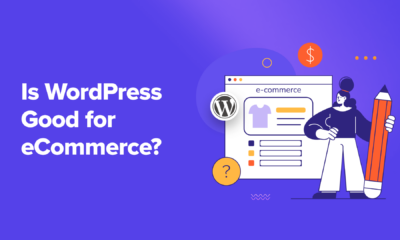

![5 Psychological Tactics to Write Better Emails → Download Now: The Beginner's Guide to Email Marketing [Free Ebook]](https://articles.entireweb.com/wp-content/uploads/2023/02/11-Free-Email-Hacks-to-Step-Up-Your-Productivity.png)


